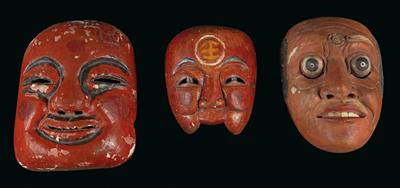Mixed lot (3 pieces): China and Indonesia: two ‘nuo theatre’ masks of southern Chinese minorities, and one ‘wayang topeng’ mask from Indonesia (Java or Bali).
Mixed lot (3 pieces): China and Indonesia: two ‘nuo theatre’ masks of southern Chinese minorities, and one ‘wayang topeng’ mask from Indonesia (Java or Bali).

1: China: two masks from the popular ‘nuo’ style of theatre, also known as ‘nuo’ opera. Originating from minority groups in southern China (the Miao, Dong, Yao, Maoan, etc.). Both masks are painted on their front side with dark red and black lacquer. One of them is a half-mask (without the sections for the lower jaw and chin). They have a white-rimmed round medallion on the forehead, painted in yellow with the word ‘wang’, which means ‘king’. The back is black.
Height: 17 cm; width: 15 cm.
The second, red and black nuo mask in this mixed lot is a laughing jester. With the old original repair of an old crack to the upper left of the mask (held together with thin iron wire). A small crack to the lower portion of the reverse. Reverse: green.
Height: 24 cm; width: 19 cm.
2: Indonesia: a mask from the ‘wayang topeng’ masque which is traditionally performed in Java and Bali with a Gamelan orchestra and choir. The present ‘wayang topeng’ mask is known as a ‘jauk’ and belongs to the characters in the ‘rangda barong’ play, which focuses on the witch Rangda and the mythical lion Barong, which is primarily performed in Bali.
The mask is carved from light-coloured lightweight wood, with a face dyed reddish brown and hemispheric protruding eyes, under which there are narrow slits for the eyes of the masked dancer. With remains of bushy eyebrows and a moustache made of goat hair that has been glued on. Originally, five teeth made of mother of pearl were glued into the smiling mouth (three are present, two have been lost due to age). The reverse was originally dyed brown. There is a minor piece broken off from the bottom of the lower rim.
Height: 21 cm; width: 16 cm.
All three masks in this mixed lot have shiny patches of a usage patina on their reverse where the cheeks and chin of the masked dancer rubbed against it.First half of the 20th century. (ME)
Provenance: French private collection; Austrian private collection.
Expert: Prof. Erwin Melchardt
 Prof. Erwin Melchardt
Prof. Erwin Melchardt
+43-1-515 60-465
erwin.melchardt@dorotheum.at
06.04.2017 - 15:00
- Vyvolávací cena:
-
EUR 600,-
Mixed lot (3 pieces): China and Indonesia: two ‘nuo theatre’ masks of southern Chinese minorities, and one ‘wayang topeng’ mask from Indonesia (Java or Bali).
1: China: two masks from the popular ‘nuo’ style of theatre, also known as ‘nuo’ opera. Originating from minority groups in southern China (the Miao, Dong, Yao, Maoan, etc.). Both masks are painted on their front side with dark red and black lacquer. One of them is a half-mask (without the sections for the lower jaw and chin). They have a white-rimmed round medallion on the forehead, painted in yellow with the word ‘wang’, which means ‘king’. The back is black.
Height: 17 cm; width: 15 cm.
The second, red and black nuo mask in this mixed lot is a laughing jester. With the old original repair of an old crack to the upper left of the mask (held together with thin iron wire). A small crack to the lower portion of the reverse. Reverse: green.
Height: 24 cm; width: 19 cm.
2: Indonesia: a mask from the ‘wayang topeng’ masque which is traditionally performed in Java and Bali with a Gamelan orchestra and choir. The present ‘wayang topeng’ mask is known as a ‘jauk’ and belongs to the characters in the ‘rangda barong’ play, which focuses on the witch Rangda and the mythical lion Barong, which is primarily performed in Bali.
The mask is carved from light-coloured lightweight wood, with a face dyed reddish brown and hemispheric protruding eyes, under which there are narrow slits for the eyes of the masked dancer. With remains of bushy eyebrows and a moustache made of goat hair that has been glued on. Originally, five teeth made of mother of pearl were glued into the smiling mouth (three are present, two have been lost due to age). The reverse was originally dyed brown. There is a minor piece broken off from the bottom of the lower rim.
Height: 21 cm; width: 16 cm.
All three masks in this mixed lot have shiny patches of a usage patina on their reverse where the cheeks and chin of the masked dancer rubbed against it.First half of the 20th century. (ME)
Provenance: French private collection; Austrian private collection.
Expert: Prof. Erwin Melchardt
 Prof. Erwin Melchardt
Prof. Erwin Melchardt
+43-1-515 60-465
erwin.melchardt@dorotheum.at
|
Horká linka kupujících
Po-Pá: 10.00 - 17.00
kundendienst@dorotheum.at +43 1 515 60 200 |
| Aukce: | Mimoevropské a domorodé umění |
| Typ aukce: | Salónní aukce |
| Datum: | 06.04.2017 - 15:00 |
| Místo konání aukce: | Wien | Palais Dorotheum |
| Prohlídka: | 01.04. - 06.04.2017 |
